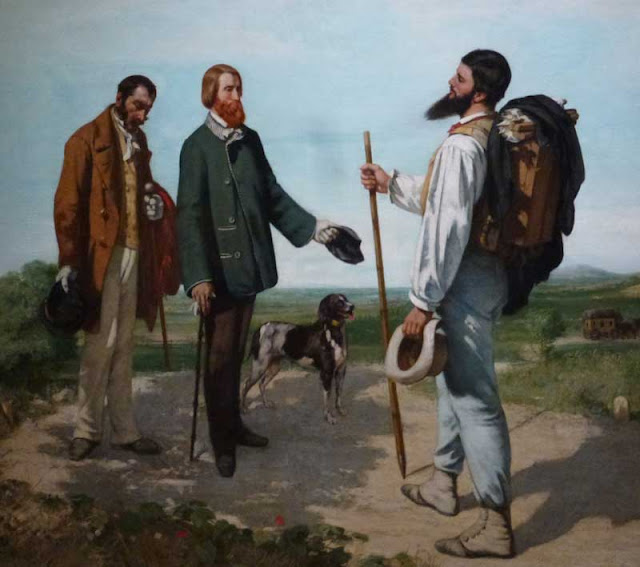LIZ SAYS: We thought we could see both the Edward Hopper show and Bohemes, but the Hopper was sold out. The Hopper show has gotten a lot of press and he’s oh so perfectly American to the French. So we were shut out of our own psyche and we walked into another.
The show started with explanations and representations of what domiciled europeans thought they saw when they saw gypsies. The paintings of carefree, unencumbered dancers wandering the lands playing exotic music and repairing pots and pans for city folk. The beautiful women in loose, flowing colorful garb telling fortunes and dancing wildly in the moonlight. They imagined them to be downfallen nobility from some faraway, now defunct kingdom or Egypt or Serbia. Hungarian music became fashionable.
From the first, the Bohemes are portrayed mostly as the viewers or artists in dress up clothes. The subjects don’t look particularly Egyptian. Their clothing looks comparatively free, for the time. Their hair looks wildly luxurious, like the hair of someone who had a pretty good diet and spent a lot of time brushing and arranging it. In other words, they didn’t look like
poor, hungry wanderers. That came later.
Once the initial fascination was over, the first thing to go was the beauty of the women. The fortune tellers started to be old, snaggle-toothed and withered, they became sinister, suspicious. The dogs stopped dancing along side the rover’s caravans. Gone were the pink cheeked tambouring players in their white swathes of bedding.
As the governments became more severe, so did the portrayals. At the same time as artists and free thinkers imagined themselves are the free roving gypsies, the reality for the people was a tad more grim.
But, the idea of the Bohemian had been born. The idea of the gypsy had taken hold. The idea of not being beholden to things, drawing outside the lines, feeding the spirit at the expense of property and wealth had taken hold.
As we entered the huge staircase that leads to the second level of the show, the world was about to change.
The initial room, upstairs, was fashioned like an artist’s garret with torn wall paper and a wood burning stove in the center. Some of the paintings were on old easels around the perimeter of the room. There were shadows painted on the walls and signs from old bars and cafes. I was enthralled with the whole scene. We had entered the life of the artist as a Bohemian.
As one of the wall texts read, the artist’s studio had gone from a place chosen for its light to a place to keep warm and work. The pictures in this space were mostly paintings of studios. Some showed the artist in the studio, often depressed, sometimes working, some were just portraits of their meager circumstances.
The next room contained a burlap covered shack. The shack was the showplace for the stars of the bohemian movement, Arturo Rimbaud and Paul Verlaine. There were little writings and sketches of the two between the wooden joists of the walls.
There had been a transformation from the reality of the Boheme to the idea of the Bohemian life. The artist was to strive to be free from the middle class social norms, whilst trying very hard to make a living.
From the shack, we entered a cafe. The entire room was full of the ubiquitous brown wooden tables and chairs of a cafe and the walls were covered with paintings of scenes of cafe life. There were papers and books to read on the tables, under the lamps that hung from a single cord from the ceiling. It was a reasonable facsimile of a really dark cafe around the turn of the 20th century.
Then, we turned the corner to see that once again, reality for the actual gypsies had turned brutal.

The works by Otto Mueller showed the truly sad state of the wandering free people as the German government tried to eradicate the actual people as well as the idea. The show ended with the revelation that these pictures were displayed in the infamous Decadent Art show.

























No comments:
Post a Comment